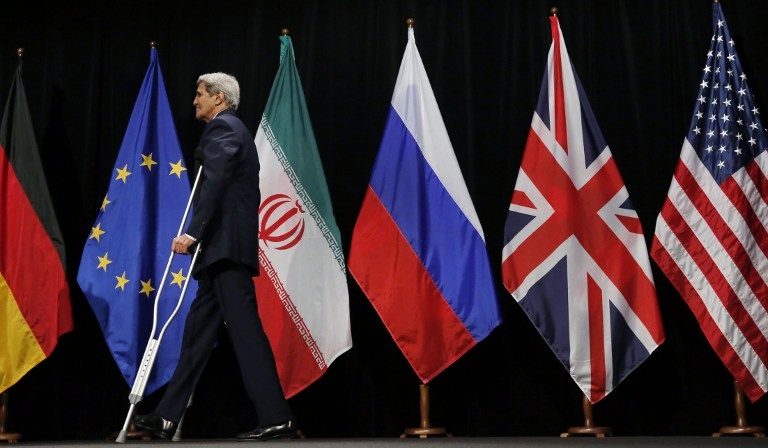SUMMARY
This is AI generated summarization, which may have errors. For context, always refer to the full article.

VIENNA, Austria – Getting the Iran nuclear deal unveiled Tuesday, July 14, was hard enough. Now it must be approved, implemented and then stuck to for years. Get set for a bumpy ride, experts warn.
“This agreement is as fragile as the forces against it are formidable. It has serious critics in Iran, the US and the region,” said Ali Vaez from the International Crisis Group think tank.
First stop for the deal, under which Iran will curb its nuclear program in return for sanctions relief, is the US Congress, controlled by opposition Republicans who are skeptical about the accord.
US lawmakers will have 60 days to chew over the highly complex agreement in what will likely be a period of high drama with intense lobbying on both sides.
US Senate Majority Leader Mitch McConnell, a Republican, warned on Sunday that the accord would be a “hard sell.” Many in the US share Israel’s concerns that the deal is too weak.
(READ: Letter inflames US feud over Iran talks)
Congress does not have to approve the deal, but it has the option of passing a resolution preventing President Barack Obama from waiving most US sanctions.
Obama can veto this, but this could be overridden if opponents can muster a two-thirds majority.
The review period could stretch to up to 82 days. The clock will start when the documents are submitted to Congress.
In Iran, approval is easier, with the deal set to be put to the Supreme National Security Council – a body composed of appointees by supreme leader Ayatollah Ali Khamenei – and then to parliament.
Implementation
Suzanne Maloney at the Brookings Institution believes that ultimately the US Congress “can’t up-end a multilateral deal.”
The noise will be more about “grandstanding” ahead of the 2016 US presidential election, she said.
Where US lawmakers could make problems, however, is in the tricky next phase after approval: putting the deal into practice, she said.
US Secretary of State John Kerry admitted this part might be tough on Tuesday: “We move now to the new phase, a phase that is equally critical and may prove to be just as difficult, and that is implementation.”
(READ: John and Javad, the odd couple who struck the Iran deal)
The curb on Iran’s nuclear program in the deal will take some time to put into practice – likely several months.
It will have to be verified by the International Atomic Energy Agency (IAEA), the UN watchdog, which is already stretched in terms of personnel and money, according to diplomats.
“It is critical to ensure that the IAEA has the resources it needs to monitor and verify the deal and that both sides fully understand the verification mechanisms,” said Arms Control Association expert Kelsey Davenport.
In step with Iran’s reduction of its program, the web of sanctions imposed over the years by the UN Security Council, the United States and the European Union will be gradually unpicked.
Part of the reason that the deal took so long to negotiate was working out the choreography of how this quid-pro-quo process will work. And it may not run smoothly.
“Implementing an agreement with this level of complexity over such a long period of time is bound to be imperfect,” Vaez said.
“But the parties will be able to overcome these hurdles with goodwill and constant communication.”
Long-term challenge
Perhaps the most difficult part will be ensuring both sides stick to their side of the bargain longer term, even though a special commission will be created to handle any violations.
The accord has a long time to run. Iran’s nuclear program, curbed under the deal, cannot expand for a decade or more. Spent reactor fuel must be exported, only enrichment to low levels is allowed.
Iran must allow the IAEA to probe allegations of past weaponization work, which may include visits to military bases – something some powerful factions in Iran may seek to block.
Another question is this: What will happen if figures who may be more hostile to the agreement come to power in Iran and the United States?
Even though Obama can waive sanctions, the laws underpinning them remain on the books, meaning his successor could decide to bring back the sanctions by executive order.
“The underlying enigma here, that I have at least, is whether this is a rapprochement between Iran and the US, or whether it is Kerry and (Iranian Foreign Minister Mohammad Javad) Zarif having a strong personal chemistry,” said Siavush Randjbar-Daemi, an Iranian lecturer at Manchester University.
“We don’t know yet whether this is a remarkable alignment of the stars which has led to this rapprochement, or whether this is something deeper,” he told Agence France-Presse.
Kerry said he was under “no illusions that the hard work is over.”
In the end, “this agreement will live or die by whether the leaders who have to implement it on both sides honor and implement the commitments that have been made,” he said. – Simon Sturdee, Agence France-Presse / Rappler.com
Add a comment
How does this make you feel?
There are no comments yet. Add your comment to start the conversation.